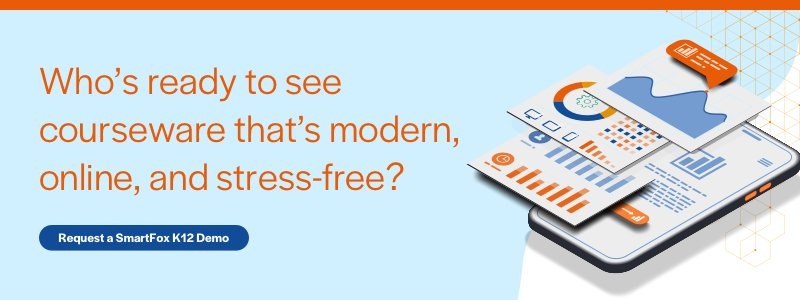
If you’re an education leader, you’ve probably already felt the seismic shift that’s taking place in education. Schools are racing to pick up new learning models, more technology, and easier ways to connect with students.
Unfortunately, education has morphed so quickly that it can be hard to pin down where modern education stands and identify exactly how e-learning fits into the equation.
We’re here to give an update on the state of modern education. Read on for the latest in e-learning, an overview of how it’s shaping education, and an in-depth look at the trends fueling its growing momentum.
How is Education Changing?
Education is morphing to include more technology, more personalized learning, and more online experiences. As schools have slowly discovered the advantages of online and hybrid learning models in recent years, full-time e-learning is poised to take off.
Wondering how that growth has hit K-12 institutions and high schools?
Currently, nearly 60 percent of public high schools offer online courses. And that number is expected to boom. Estimates suggest the e-learning industry will more than double in size over the next five years.
Overall, e-learning has already become a large part of the education industry, and it appears to be positioned to dominate the learning landscape in the future.
What’s Causing the Shift Toward E-Learning?
This revolutionary shift toward e-learning is inspired by both new developments and less obvious undercurrents.
The most obvious and immediate cause of this shift is due to recent COVID-19 changes. The pandemic has shut down schools across the globe and forced 1.3 billion students worldwide out of physical classrooms. At the moment, e-learning is becoming the most practical way to safely educate students. And many schools are getting a taste of the ongoing benefits of learning online for the first time.
However, schools were moving toward e-learning long before the pandemic started sweeping the globe. In fact, even before COVID-19 started baring its teeth, experts estimated the online education market would reach $350 billion by 2025.
Why?
One reason is a general shift toward more effective learning models. In recent years, educators have been exploring new learning models that rise above the traditional classroom and encourage better outcomes. In many cases, that has meant ditching rote learning and lecture-only teaching for learning that encourages critical thinking and takes place in more personalized classrooms. E-learning technology allows teachers to deploy advanced learning techniques and reach students on a deeper level.
At the same time, students are becoming more and more comfortable with online environments. In fact, according to Pew research, nearly half of teens admit to being online “almost constantly.”
As a whole, the stars seem to be aligning, and all signs point to more change for education in the future.
How Does E-Learning Fit In?
Not sure how e-learning looks in action? You’re not alone. Many education professionals are hesitant to dive into online learning because it takes place in a new, relatively foreign environment. However, for schools embracing technology, e-learning has presented overwhelmingly positive ways to promote learning.
Here’s how advanced e-learning platforms are letting educators outgrow the traditional school setting and drive even more meaningful learning outcomes:
- More flexible learning models: E-learning lets educators deliver content in a more flexible, personalized way. It allows schools to implement new learning models to fit a broader set of learning styles. That means leaders have more tools to reach students on a more intimate level.
- Meeting students where they’re comfortable: Young learners are growing up in a world where technology is a part of everyday existence. They’re increasingly comfortable with online life. E-learning meets students in the environment they’re used to and allows them to continue learning regardless of their physical location. That means more students have access to education, and they have the freedom to manage their own schedules more effectively.
- Technology is enhancing outcomes: Beyond being convenient, technology is inspiring more complete learning outcomes. Online platforms feature personalized content, self-paced lessons, and coursework that adjusts to the learner. At the same time, built-in analytics allow leaders to pinpoint academic barriers, address holdups effectively, and report the results for faster progress.
How Are Leaders Using Online Learning Platforms?
When it comes to online learning, teachers are usually in the spotlight. Still, there are less front-and-center groups and individuals who are seeing advantages of online learning. And they’re pushing for advanced learning platforms.
Here are some groups and individuals who are championing advanced e-learning programs:
Public Charters and Private Schools
Although e-learning appeals to institutions of all types, public charter schools and private schools are flocking to online learning. Because these institutions tend to promote flexible learning models, e-learning fits beautifully with charter and private school plans. At the same time, these schools are often under added pressure to monitor, measure, and prove positive learning results.
Advanced online learning platforms make measuring outcomes and reporting figures much simpler than within the traditional in-person classroom. That means it’s easier to gain accreditation, secure funding, and uphold standards.
Administrators
Administrators may not be the most public-facing educational leaders, but they play a critical role in student success. Fittingly, online platforms are making it easier for administrators to do their jobs successfully. Here are some ways e-learning is lifting stress off administrators:
- Easier faculty management: With advanced platforms, administrators can clearly see learning outcomes and measure faculty progress. Additionally, advanced online platforms will incorporate easy-to-use learning tools, such as Zoom, into learning systems. With intuitive tools and clear reports, administrators spend less time tracking down information, less time coaching faculty, and more time creating positive educational progress.
- More access to information: Advanced online platforms, such as SmartFox K12, integrate a school’s learning management system (LMS) and student information system (SIS). With information flowing into a single stream, administrators can easily pull and send reports with ease. That makes it easier to secure funding, pick up accreditation, and improve the school.
- More measurable outcomes: The right online system will include analytics that are built into the school’s LMS. This makes it easy to track the performance of students and instructors. In turn, administrators have all the information they need to drive better learning outcomes.
Counselors
In many schools, counselors have become the biggest advocates for e-learning. Here’s why:
- More flexible, remote work: With e-learning, counselors have the freedom to connect with students from anywhere. That means they aren’t restricted by normal office hours, it’s easier to reach students during the summer, and they can promote learning from the locations they choose.
- More in-depth graduation planning: Some advanced learning platforms include designated graduation planners and easy-to-access information. With more exposure to planning tools, it’s easier for counselors to drive lifelong success.
- Personalized outcomes: Online learning can include personalized coursework that allows students to move at their own pace. That means it’s easier for counselors to help students catch up and qualify for post-secondary opportunities.
See How the Right E-Learning Platform Can Help Your School
E-learning is driving new opportunities for students across the globe, but not all online platforms are equal. If you want your school to succeed online, it all starts with the right e-learning platform.
SmartFox K12’s Online Learning program is built by and for educators. Here are a few reasons SmartFox K12 is a cut above other online platforms:
- It includes an integrated LMS + SIS design
- It uses self-paced, personalized coursework
- It incorporates advanced graduation planning tools, intuitive student dashboards, and built-in analytics
- Coursework is stimulating, mobile-friendly, and approved by the University of California (UC) system
Want to learn more about how SmartFox K12’s Online Learning platform can lift the load off of your education team? Talk with one of our education experts today and learn more.
About the Author
-1.jpeg)
Dr. Jessica Spallino
Jessica has a demonstrated track record of building schools that are forward-thinking, high-performing, and often unconventional. She is particularly experienced at building online and blended learning charter schools, and has a passion for improving K-12 education through new and innovative models and concepts. She’s regularly asked to speak on change management and building positive and innovative cultures in schools and in the workplace. Jessica holds a BA in English, an MA in Educational Leadership, and holds PhD in Curriculum and Instruction from New Mexico State University.


